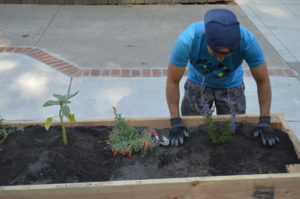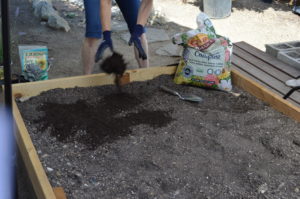Raised Bed Gardening
Gardening in raised beds offers a solution to work around common obstacles in the garden such as poor soil, limited planting space, or issues with accessibility. There is almost no limit to what you can grow in them! Vegetables, fruits, and ornamentals can all thrive in a raised bed. Once your raised beds are built, you’ll reap the benefits they offer season after season.
There are many benefits to raised bed gardening but here are a few of the most common reasons people use them:
- Greater Accessibility: Raised beds offer gardeners with physical limitations easier access to plants by eliminating the need to bend and reach as far.
- More Adaptability: Raised beds can be constructed in sizes to fit any garden and to optimize access to sunlight and irrigation.
- Improved Soil: If your garden soil is contaminated, compacted, or has poor drainage, raised beds can be the ideal workaround. You can create the perfect soil blend for whatever you want to grow.
- Longer Growing Season: Soil in raised beds warms earlier than ground soil, which means plants will begin to grow, flower, and fruit earlier.
- Higher Yields: Raised beds are a perfect setting for intensive planting plans, allowing you to fit more plants into each square foot of soil so your garden will be more productive.
Choose Your Materials
Raised beds are typically constructed of pressure-treated pine but can also be built out of a naturally rot-resistant wood such as redwood, cedar, cypress, or oak or composite material made from recycled wood and plastic. Pine is the least expensive option; and composites are moderately priced. There are also prefabbed raised bed options such as metal tubs and troughs that you can purchase from garden accessory retailers. Be aware that pressure-treated wood and some metals can leach chemicals into the soil, which can then be absorbed by the plants—avoid these materials if you’re growing edible plants.
Size Matters
Raised beds should be planned so that they are narrow enough that you can reach the plants in the middle without having to crawl into the bed—usually no more than 4 feet wide. You can make the beds as long as you want but keep in mind that you may need to haul tools and hoses around the beds, so size them accordingly. Paths in between beds should be wide enough for you to move and work comfortably, at least 3 feet. And the beds should be deep—8 inches at a minimum, although 18 to 24 inches is better and 30 inches may be helpful if mobility is a problem and the gardener needs to minimize bending.
One of the biggest advantages of using raised beds is that you can create a soil mix that is perfectly suited to what you’re growing. If you’re growing acid-loving edibles like blueberries or tomatoes, you can fill the bed with a soil mix with a lower pH level. You can also improve the drainage by adding amendments like perlite or fine redwood chips.
Irrigate and Protect
Your raised beds will be even more efficient if you set up drip irrigation in them. To protect your crops from insects and birds or from intense sun exposure, you can use PVC pipe to make hoops over the beds that you can cover with shade cloth.
Refresh Each Season
You’ll notice the soil level in your raised beds go down during the year as the organic material decomposes. You can continually renew the soil by adding side-dressings of compost between plants. You don’t have to dig it in—worms and other insects will do the heavy lifting for you to incorporate it into the existing soil. Whenever you replace crops at the end of the growing season, it’s a good idea to add a few inches of compost over the entire bed before planting the next crop.

